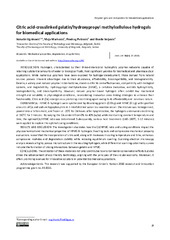Prikaz osnovnih podataka o dokumentu
Citric acid-crosslinked gelatin/hydroxypropyl methylcellulose hydrogels for biomedical applications
| dc.creator | Ugrinović, Vukašin | |
| dc.creator | Marković, Maja | |
| dc.creator | Petrović, Predrag | |
| dc.creator | Veljović, Đorđe | |
| dc.date.accessioned | 2024-04-02T06:50:04Z | |
| dc.date.available | 2024-04-02T06:50:04Z | |
| dc.date.issued | 2024 | |
| dc.identifier.issn | 0367-598X | |
| dc.identifier.uri | http://TechnoRep.tmf.bg.ac.rs/handle/123456789/7393 | |
| dc.description.abstract | INTRODUCTION: Hydrogels, characterized by their three-dimensional hydrophilic polymer networks capable of retaining substantial amounts of water or biological fluids, hold significant promise for biomedical and pharmaceutical applications. While numerous polymers have been explored for hydrogel development, those derived from natural sources possess inherent advantages due to their abundance, affordability, biocompatibility, and biodegradability. Gelatin, a widely used natural polymer in biomedicine, standsout for its cost-effectiveness, compatibility with biological systems, and degradability. Hydroxypropyl methylcellulose (HPMC), a cellulose derivative, exhibits hydrophilicity, biodegradability, and biocompatibility. However, natural polymer-based hydrogels often exhibit low mechanical strength and solubility in physiological conditions, necessitating innovative cross-linking strategies to enhance their functionality. Citric acid (CA) emerges as a promising crosslinking agent owing to its affordability andnon-toxic nature.EXPERIMENTAL:HPMC-G hydrogels were synthesized by dissolving gelatin (0.05 g) and HPMC (0.1 g) with specified amounts of CA and sodium hypophosphitein 1 ml of distilled water in a reaction vessel. The mixture was homogenized, poured into a Teflon mold, and frozen at -20°C for 24 hours. After lyophilization, the hydrogels underwent crosslinking at 160°C for 7 minutes. By varying the CA content from 0%to 40% (w/w) while maintaining constant temperature and time, the optimal CA/HPMC ratio was determined. Subsequently, various heat treatments (140–180°C, 3-12 minutes) were applied to explore the optimal curing conditions.RESULTS AND DISCUSSION:The investigation elucidates how the CA/HPMC ratio and curing conditions impact the physicochemical and mechanical propertiesof HPMC-G hydrogels. Swelling tests and compressive mechanical property evaluations reveal that the incorporation of citric acid, along with increases in curing temperature and time, enhances compressive modulus and degradation stability while reducing equilibrium swelling. Scanning electron microscopyanalysis reveals a highly porous microstructure in the resulting hydrogels, while differential scanning calorimetrycurves indicate the formation of strong interactions between gelatin and HPMC.CONCLUSIONS:The utilization of these materials notonly contributes to environmental conservation efforts but also drives the advancement of eco-friendly technology, aligning with the principles of the circular economy. Moreover, it offers promising avenues for innovative solutions in potential biomedicalapplications. | sr |
| dc.language.iso | en | sr |
| dc.publisher | Savez hemijskih inženjera Srbije | sr |
| dc.relation | European Union’s Horizon 2020 research and innovation programme, grant no. 952033 | sr |
| dc.rights | openAccess | sr |
| dc.rights.uri | https://creativecommons.org/licenses/by/4.0/ | |
| dc.source | Hemijska industrija - Supplementary Issue - ExcellMater Conference 2024 Abstracts | sr |
| dc.subject | Mechanical properties | sr |
| dc.subject | degradation | sr |
| dc.subject | drug delivery | sr |
| dc.title | Citric acid-crosslinked gelatin/hydroxypropyl methylcellulose hydrogels for biomedical applications | sr |
| dc.type | conferenceObject | sr |
| dc.rights.license | BY | sr |
| dc.citation.issue | 1S | |
| dc.citation.spage | 29 | |
| dc.citation.volume | 78 | |
| dc.description.other | ExcellMater Conference 2024: Innovative Biomaterials for Novel Medical Devices, Belgrade, Serbia, April 10-12, 2024 | |
| dc.identifier.fulltext | http://TechnoRep.tmf.bg.ac.rs/bitstream/id/20469/ExcellMater_3.pdf | |
| dc.identifier.rcub | https://hdl.handle.net/21.15107/rcub_technorep_7393 | |
| dc.type.version | publishedVersion | sr |

